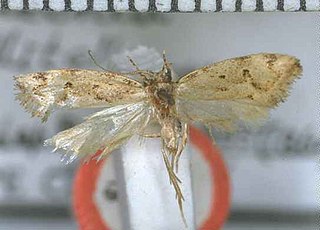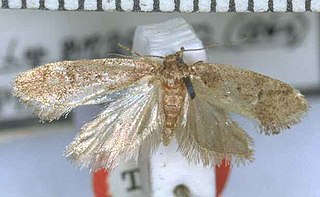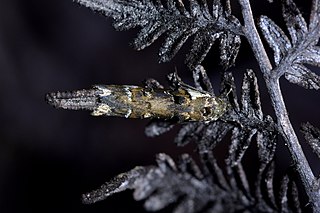Chlorolychnis is a genus of moths in the family Gelechiidae. It contains the species Chlorolychnis agnatella, which is found in Indonesia (Java) and Sri Lanka.

Izatha copiosella is a moth of the family Oecophoridae. It is endemic to New Zealand, where it is found on the south-eastern parts of the North Island and throughout the South Island except the West Coast. Larvae are found in dead wood and are likely to use kōwhai species as hosts. The adults are night fliers and are attracted to light. They are on the wing in January and February.
Gelechia flavipalpella is a moth of the family Gelechiidae. It is found in the Democratic Republic of Congo and South Africa.
Gelechia angustella is a moth of the family Gelechiidae. It is found in Sri Lanka.
Compsoctena connexalis is a moth in the family Eriocottidae. It was described by Francis Walker in 1863. It is found in South Africa.
Brachmia alienella is a moth in the family Gelechiidae. It was described by Francis Walker in 1864. It is found in Sri Lanka.
Dichomeris permundella is a moth in the family Gelechiidae. It was described by Francis Walker in 1864. It is found in Peru and Amazonas, Brazil.
Ardozyga vacatella is a species of moth in the family Gelechiidae. It was described by Francis Walker in 1864. It is found in Australia, where it has been recorded from Queensland.
Gelechia aglossella is a moth of the family Gelechiidae. It is found in South Africa.
Gelechia albatella is a moth of the family Gelechiidae. It is found in Sri Lanka.
Gelechia gammanella is a moth of the family Gelechiidae. It is found on Borneo.
Gelechia marmoratella is a moth of the family Gelechiidae. It is found in Australia, where it has been recorded from New South Wales.
Gelechia petraea is a moth of the family Gelechiidae. It is found in Guatemala.
Deltoplastis amicella is a moth in the family Lecithoceridae. It was described by Francis Walker in 1864. It is found in India (Assam), Myanmar and Sri Lanka.
Allotropha is a monotypic moth genus in the family Depressariidae described by Alexey Diakonoff in 1954. Its only species, Allotropha percussana, was described by Francis Walker in 1864. It is found in Australia, where it has been recorded from Tasmania.
Stenoma dispilella is a moth in the family Depressariidae. It was described by Francis Walker in 1866. It is found in Colombia.
Moca velutina is a moth in the family Immidae. It was described by Francis Walker in 1863. It is found in Sri Lanka.

Tingena collitella is a species of moth in the family Oecophoridae. It is endemic to New Zealand and has been observed in Auckland.

Tingena innotella is a species of moth in the family Oecophoridae. It is endemic to New Zealand and is found in both the North and South Islands. This species inhabits open native forest or scrubland and adults are on the wing from December to March. T. innotella appears to have an affinity for the silver tree fern.

Trachypepla conspicuella is a species of moth in the family Oecophoridae. It is endemic to New Zealand and is found in both the North and South Islands. It is similar in appearance to its close relative T. euryleucota but tends to be paler. Its colouration imitates bird droppings. Larvae feed on leaf litter. Adults of this species are on the wing from November to February and have been observed resting on fences and walls.



